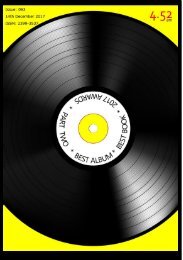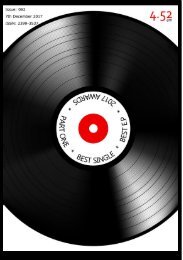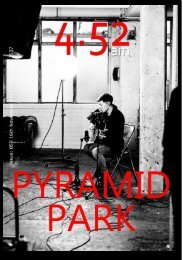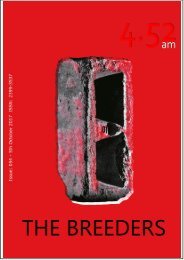4.52am Issue: 008 13th November 2016
Your Free Weekly Guitar and Alternative Music Weekly Magazine from Guitar Quarterly
Your Free Weekly Guitar and Alternative Music Weekly Magazine from Guitar Quarterly
Create successful ePaper yourself
Turn your PDF publications into a flip-book with our unique Google optimized e-Paper software.
ANDY MANSON<br />
A Bouzouki for Andy Lambert<br />
I hate to start an article by suggesting that<br />
we are moving from the ridiculous to the<br />
sublime, but in terms of approach to guitar<br />
making, I think we can safely say that Andy<br />
Manson comes from a more traditional<br />
direction.<br />
I’m genuinely pleased to say that Guitar<br />
Quarterly will have a full feature on Andy’s<br />
work in January, which is rightly regarded as<br />
some of the finest in the world, but I didn’t<br />
want too many issues of <strong>4.52am</strong> to pass<br />
without having at least a little look at one of<br />
his builds.<br />
As you would imagine, Andy Manson makes<br />
all his guitars, mandolins and in the case of<br />
today’s example, bouzoukis entirely by<br />
hand, as he has done for over 40 years. To<br />
date he has made more than a thousand<br />
instruments and is still taking the finest of<br />
woods and discovering the beauty within<br />
both aesthetically and tonally.<br />
I asked him about his approach to<br />
tonewoods and whether he thought that<br />
there is really any merit in the idea?<br />
“I use most of the classic timbers for guitar<br />
and mandolin construction. Rosewood,<br />
spruce, mahogany, cedar, ebony, maple. I<br />
like to use locallysourced woods as well,<br />
when possible. A particular favourite is<br />
English and European cherry.<br />
The maple I use is grown in Europe, as is<br />
most of the<br />
spruce. I like to use some of the other<br />
traditional instrument making woods that<br />
have not been so common in modern<br />
instruments, such as boxwood, pear,<br />
apple, yew. I have laburnum, plum,<br />
sycamore, walnut, strawberry wood, olive.<br />
The particular sound of the instrument is<br />
created by the interaction of the strings<br />
and what they are attached to. The<br />
variables apart from string characteristics<br />
are weight, density, stiffness, size and<br />
shape. Different woods have different<br />
degrees of weight, density and stiffness.<br />
In 1967 I built my first instrument, from<br />
necessity. It was a teardrop shaped body<br />
with a long neck and 30” scale. I don't<br />
remember what inspired the long scale,<br />
though I remember measuring strings to<br />
see how long I could make it. I think I<br />
hoped for a more strident sound with a<br />
long string.<br />
The body had plywood sides with oak top<br />
and back and an African mahogany neck<br />
with teak fingerboard. Not traditional, just<br />
what happened to be lying around in my<br />
Father's garage.<br />
The thing could deliver a tune though and<br />
I played it all over London, Paris, the Cote<br />
D'Azur and anywhere else I landed. Then<br />
there was a car crash, the guitar's top was<br />
smashed in.


















